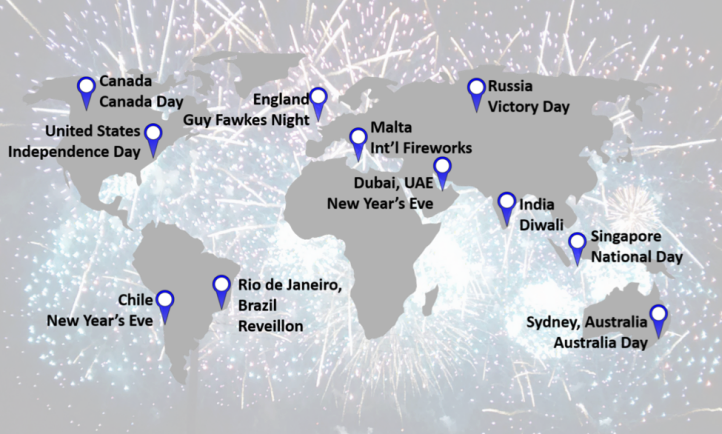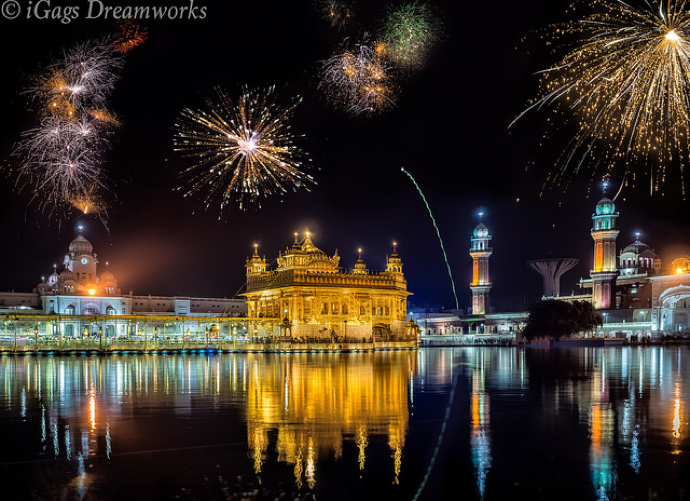The first time I used a hand-held sparkler was just a year ago. As I watched small sparks fly off of it and waved it to leave different trails of light, I wondered, “What’s in a sparkler and does it have anything to do with nanoscience?”
Fire and lights have captured the curiosity and imagination of humanity for centuries and fireworks are no different. These impressive pyrotechnic displays are used at celebrations all year round, including the Fourth of July in the United States, Guy Fawkes Day in the United Kingdom, Diwali in India, Christmas in Peru, and of course, to ring in the New Year.1 In a previous Sustainable Nano post, we wrote about how nanoparticles are used in professional fireworks to make them more impressive and environmentally friendly.

Fireworks, including firecrackers and early sparklers, originated in China somewhere between 600 and 900 B.C.E and the basic recipe for them hasn’t changed very much since.2 So if you don’t live near a big fireworks display, you might buy your own small pyrotechnics like sparklers and roman candles at roadside stands to celebrate with your family and friends like I did (only if it is legal of course). The modern sparkler has been available since 1975 and contains three basic components: a metallic fuel, an oxidizer, and a combustible binder to hold the fuel and oxidizer together.3

The base color of the sparks depends on the fuel. For example, the classic whitish sparks are produced by a blend of aluminum and magnesium fuels. Sparklers may also contain additional metals to produce a wide variety of colors. Copper (Cu) salts will give the sparkler a blue color while sodium (Na) salts will impart a yellow hue.
For many of us, thinking of sparklers and fireworks might drum up memories of Fourth of July festivities, but firework displays are the hallmark of many celebrations across the globe. Sparklers, along with other small consumer fireworks, are popular at Diwali, the Hindu festival of lights. High rates of firework use during Diwali inspired research into their possible health effects. Researchers at the Indian Institute for Chemical Technology investigated the air quality in various areas in India after Diwali.4 They discovered that the metal pollution in the air was much higher than in previous days. Reports of metal pollution and air quality concerns due to the burning of these consumer fireworks has even led to limitations on how many fireworks can be used in Diwali celebrations.5

While it is clear that particulate matter is left in the air after burning sparklers, researchers at the Jozef Stefan Institute wanted to know if sparklers were producing nanoparticles.6 (Remember, a nanoparticle is a particle that is from 1 to 100 nm, or one billionth to 100 billionths of a meter in diameter.) The Jozef Stefan team sampled air from three distances away from a burning sparkler: 65 cm, 1.5 m, and 3.0 m. At 65 cm, they sampled the air to determine what the exposure would be to a child (or perhaps a graduate student) handling the sparkler. At 1.5 m, air was sampled to determine what the exposure would be to an adult monitoring a child, or other near bystanders. At 3.0 m, air was sampled to determine ambient exposure and pollution levels for those farther away. The air was monitored over the course of a half hour, during and after enjoying the bright lights of the sparkler.

Air samples were analyzed with instruments that separate particles by size, and using a particle counter, scientists were even able to determine just how many particles were produced. It turns out that millions of particles are produced from a single sparkler! Collected particles were examined with a battery of techniques including electron microscopy to visualize the particles and X-ray techniques to gain information about their elemental composition.

Nanoparticles ranging from a couple nanometers to a couple hundred nanometers were discovered as byproducts of the sparklers burning. The most common sizes were around 14 nm and 100 nm although the majority of particles were in between 70 and 200 nm. The combustion of the single sparkler increased the particle concentrations in the air in the room by 150 times their standard levels!
The nanoparticles produced by sparklers were made of various metal compounds including barium aluminate (BaAl2O4), barium monoferrite (BaFe2O4), and tribarium aluminate (Ba3Al2O6). The inclusion of barium, iron, and aluminum in these byproducts is no surprise. Aluminum and iron are the metallic fuel in sparklers. Barium is often added to provide a greenish hue. If sparklers of various other colors like blue (copper colorant), red (strontium colorant), or yellow (sodium colorant) were burned, one might expect other compounds containing these metals to be produced as nanoparticles too.

As for the health and environmental impact of the nanoparticles produced by sparklers, more research is required. We know that sparklers and other small consumer-grade fireworks can increase pollution after use. However, the effects on human health – especially the lungs of children, the main audience for sparklers – are unknown. For now, the authors of the sparkler study emphasize that these small pyrotechnics should always be used outdoors to allow for air exchange and to minimize chronic exposure to nanoparticles; they also encourage the development of safer (but still impressive) fireworks.
So next time you light up a sparkler for New Years, July 4th, or Diwali, take a moment to think about the millions of nanoparticles being produced by this beautiful invention.
EDUCATIONAL RESOURCES
- Smithsonian: 14 Fun Facts About Fireworks by Helen Thompson
- Video: A Safer “Rainbow Flame” Demo for the Classroom
- Scientific American: Why do certain elements change color over a flame?
REFERENCES
- Kuoni.co.uk. Fireworks celebrations around the world.
- Thompson, H. 14 Fun Facts About Fireworks. Smithsonian.com, July 4, 2014.
- Long, R., Mcmanus, H., Wigal V. Sparkler composition. United States Patent. US 3862865 A.
- Kulshrestha, U.C., Rao, T.N., Azhaguvel, S., Kulshrestha, M.J.. Emissions and accumulation of metals in the atmosphere due to the crackers and sparkles during Diwali festival in India. Atmospheric Environment, 2004. doi: 10.1016/j.atmosenv.2004.05.044
- Chappell, B. Diwali Fireworks are Limited in India Over Toxic Smog Concerns. NPR.org, Oct 13, 2017.
- Remškar, M., Tavčar, G., Škapin, S. Sparklers as a nanohazard: size distribution measurements of the nanoparticles released from sparklers. Air Quality, Atmosphere, and Health. 2015, 8 (2), 205–211. doi: 10.1007/s11869-014-0281-8
